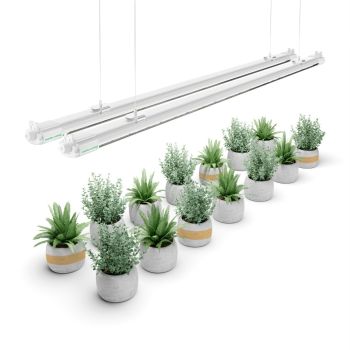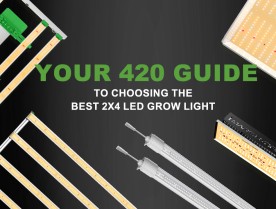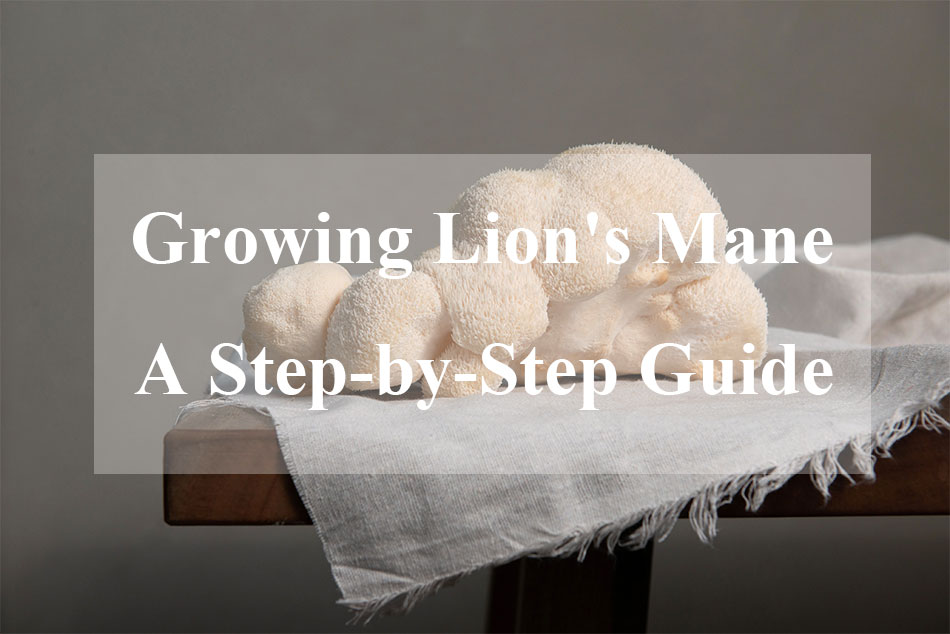
Embarking on the journey of cultivating Lion's Mane mushrooms offers a fascinating and enriching experience. Known for their distinctive, shaggy appearance and numerous health benefits, Lion's Mane mushrooms are a unique addition to any indoor or outdoor garden.
This comprehensive guide will walk you through the process of growing Lion's Mane mushrooms, covering everything from understanding the mushroom to harvesting and storage.
Before delving deeper into the fascinating world of Lion's Mane mushrooms, here's a quick overview of what you'll find in this comprehensive guide:
Table of Contents
Understanding Lion's Mane Mushroom
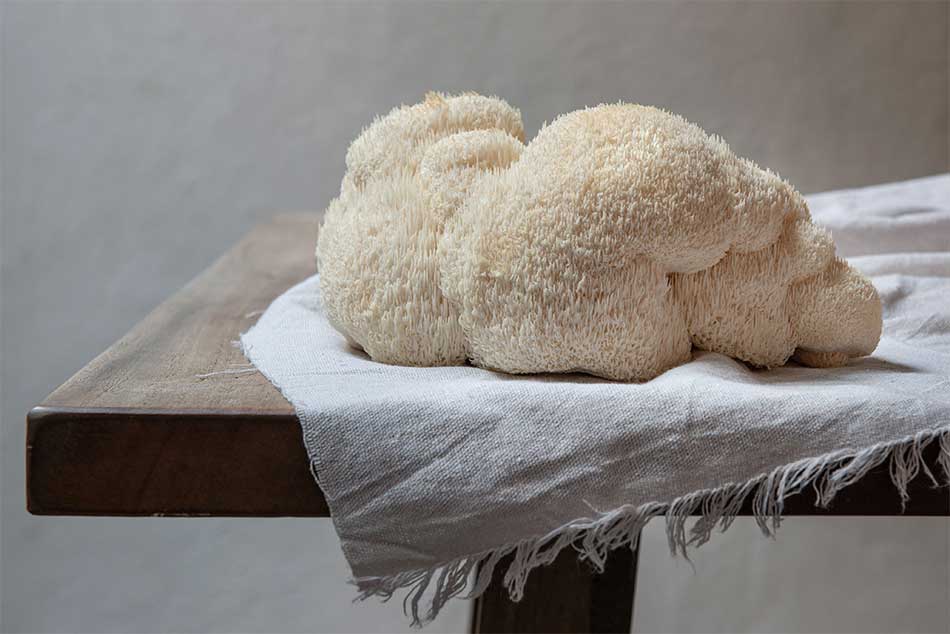
What Is Lion’s Mane Mushroom?
Lion's Mane mushroom, scientifically known as Hericium erinaceus, is a unique type of edible fungus notable for its long, shaggy spines that resemble a lion's mane as they grow. This mushroom is found growing wild on hardwoods in temperate regions of the world.
Lion's Mane is not only prized for its culinary uses, due to its lobster-like flavor and meaty texture, but also for its potential medicinal properties. It has been studied for its neuroprotective benefits and is believed to support cognitive function and brain health.
Additionally, it may have anti-inflammatory, antioxidative, and immunostimulating effects. This combination of delicious flavor and potential health benefits makes Lion's Mane a popular choice for both cooking and supplementation.
Understanding Lion’s Mane Cultivation
Cultivating Lion's Mane mushrooms (Hericium erinaceus) is a fascinating process that requires a keen understanding of their natural habitat and lifecycle. Originating from North America, Europe, and Asia, these mushrooms thrive in the wild on hardwoods, often found on dying or dead trees like oak, walnut, and beech.
To successfully cultivate Lion’s Mane, it is crucial to mimic these natural conditions as closely as possible. This involves understanding several key factors:
-
Substrate Preference: Lion’s Mane mushrooms prefer hardwood substrates. In the wild, they grow on trees, but in cultivation, substrates like hardwood sawdust, chips, or logs are used. The substrate provides the necessary nutrients for the mushrooms to grow.
-
Temperature and Humidity: These mushrooms thrive in temperatures ranging from 15 to 24°C (60 to 75°F). Humidity levels should be maintained at around 85-95% for optimal growth. These conditions mirror the damp, cool environments where Lion’s Mane naturally grows.
-
Lighting Conditions: Lion’s Mane mushrooms, while not requiring direct sunlight, still need some light for proper growth. For indoor cultivation, indirect sunlight or artificial LED grow lights that mimic natural light are suitable. The Mars Hydro VG80 LED T5 Grow Light is an excellent option in this regard, offering a full-spectrum design and low power consumption, perfectly mimicking the natural light essential for these mushrooms. Its suitability for low DLI environments and water-resistant features make it a practical choice, efficiently maintaining ideal lighting conditions in the humid environment needed for Lion's Mane mushroom cultivation.
-
Air Exchange: Adequate air exchange is essential in cultivating Lion's Mane mushrooms to prevent the buildup of carbon dioxide, which can impede their growth. This process emulates the natural airflow found in their wild habitat. The Mars Hydro 4 Inch Inline Duct Fan with Speed Controller is particularly effective in this regard. It provides efficient ventilation and airflow management, necessary for maintaining optimal air quality and gas exchange. Additionally, its quiet operation and durable design ensure a stable and undisturbed growing environment, mirroring the conditions Lion's Mane mushrooms would experience in nature.
-
Growth Cycle Understanding: Lion's Mane has a distinct growth cycle, starting from spore to mycelium, then to primordia (baby mushrooms), and finally to mature fruiting bodies. Understanding this cycle is crucial for timing interventions like substrate changes, humidity adjustments, and harvest.
By replicating these conditions, cultivators can grow Lion's Mane mushrooms either indoors, using controlled environments like grow tents and bags, or outdoors on logs, which is a more natural but slower process. The key is to create an environment that closely mirrors their natural growing conditions, leading to a successful and rewarding cultivation experience.
Choosing Your Cultivation Method
Embarking on the cultivation of Lion's Mane mushrooms is a rewarding endeavor that brings with it a pivotal choice: the method of cultivation. This decision shapes not only the trajectory of your growing experience but also influences the yield and quality of your mushrooms.
Understanding the specifics of each method is crucial for both beginners and experienced growers, as it determines the level of care, the environment needed, and the overall approach to nurturing these unique fungi.
Growing in Bags
Growing Lion's Mane in bags typically involves using sterilized substrates such as hardwood chips, sawdust, or grain. This method is favored for its controlled environment, allowing growers to manage factors like humidity, temperature, and air circulation with precision.
It's particularly advantageous for indoor cultivation, as it requires less space and can yield mushrooms more quickly than log cultivation. The controlled conditions also reduce the risk of contamination and enable year-round cultivation, independent of outdoor weather conditions.
Growing on Logs
Conversely, growing Lion's Mane on logs mimics their natural growing conditions. This method uses hardwood logs as a substrate, into which mushroom spawn is introduced. The process is closer to how Lion's Mane mushrooms grow in the wild, often resulting in a more natural taste and texture.
However, this method requires more space and patience; it can take a year or more for the mushrooms to fruit. The log cultivation method is heavily dependent on external conditions like weather, which can make it more challenging but also more rewarding for those seeking a traditional mushroom growing experience.
Both methods have their unique appeals and challenges, and your choice will depend on your personal preferences, available space, and the resources at your disposal. Whether you opt for the controlled environment of bag cultivation or the natural approach of log cultivation, both pathways offer a fulfilling journey into the world of mushroom growing.
Mastering Indoor and Outdoor Growing Techniques
Having explored the different methods of cultivating Lion's Mane mushrooms - growing in bags and on logs - it's time to delve deeper into the specifics of indoor and outdoor cultivation. These two environments present distinct challenges and opportunities. In this section, we will delve into the detailed processes of cultivating Lion’s Mane mushrooms, both indoors and outdoors.
Indoor Cultivation
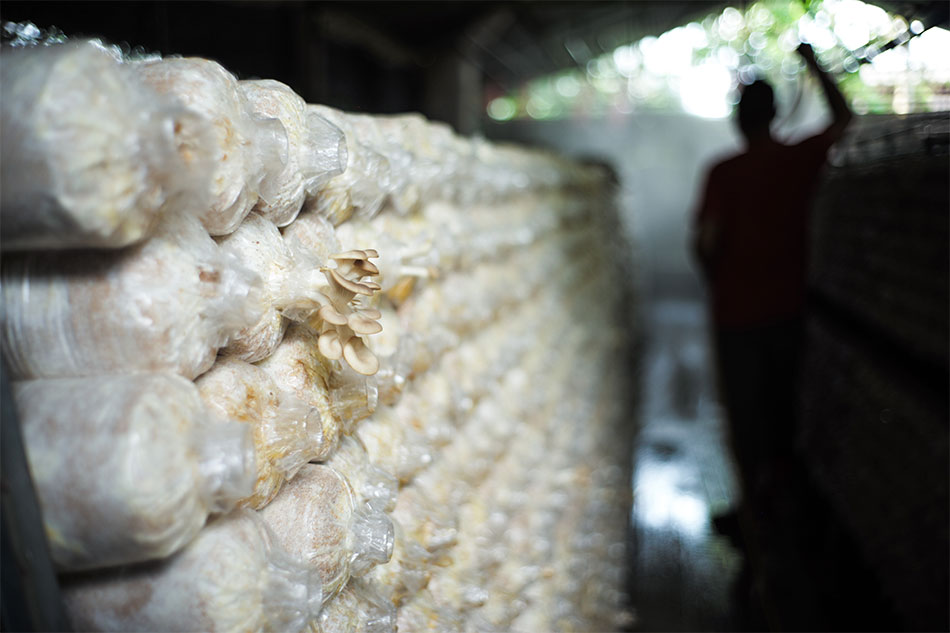
Indoor cultivation offers a controlled environment, which is crucial for the delicate early stages of mushroom growth. The following steps will guide you through this process:
Step 1: Preparing Your Supplies & Growing Space
Selecting the right supplies and preparing your growing space are fundamental. For growing Lion's Mane, wood chips or sawdust, available at garden centers or specialty stores, serve as an ideal substrate. Additionally, you'll need spawn, bags, and sterilization equipment, obtainable from mushroom cultivation suppliers.
Step 2: Preparing Your Mushroom Substrate
The preparation of your mushroom substrate is a crucial step in the cultivation of Lion's Mane mushrooms. The substrate not only serves as a growing medium but also provides essential nutrients for the mushrooms. Common substrates for Lion's Mane include hardwood chips or sawdust, reflecting the mushroom's natural preference for hardwoods in the wild.
Choosing the Right Substrate
The choice of substrate impacts the growth rate and yield of your mushrooms. Hardwood substrates such as oak, beech, or maple are ideal for Lion's Mane. These can be obtained in the form of chips, sawdust, or pellets. The size and type of the wood affect the surface area for mycelial growth and the amount of nutrients available.
Sterilization Process
Sterilizing the substrate is critical to prevent contamination from other fungi or bacteria. This can be done through several methods:
- Steam Sterilization: This involves exposing the substrate to steam for a certain period, usually in a pressure cooker or a steam sterilizer. The goal is to reach a temperature that kills potential contaminants without degrading the quality of the substrate.
- Chemical Sterilization: Using a chemical sterilant like hydrogen peroxide or lime can also be effective. This method is less commonly used but can be suitable for smaller-scale or home cultivations.
- Pasteurization: This is a milder form of sterilization where the substrate is heated to a lower temperature, which is sufficient to kill most contaminants but preserves some beneficial microorganisms.
Preparing the Substrate
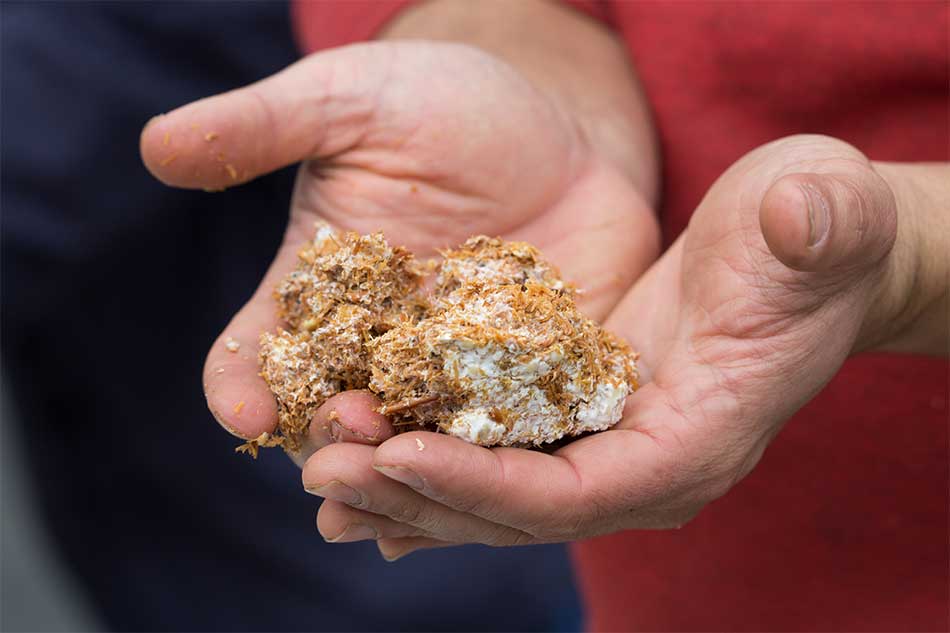
Once sterilized, the substrate should be cooled to room temperature before inoculation. It's important to handle the substrate in a clean environment to avoid reintroducing contaminants. The moisture content of the substrate is also crucial; it should be moist but not wet, as excessive moisture can lead to mold growth.
Properly preparing your mushroom substrate is a foundational step in ensuring a healthy and abundant growth of Lion's Mane mushrooms. This process sets the stage for successful inoculation and further steps in the cultivation process.
Step 3: Inoculating Your Mushroom Substrate
Inoculation is a pivotal step in mushroom cultivation where you introduce mushroom spawn into your prepared substrate. This process lays the foundation for the growth and development of the Lion's Mane mushrooms, making it crucial to execute with care and precision.
Creating a Sterile Environment for Inoculation
Maintaining a sterile environment during inoculation is critical to prevent contamination by unwanted microorganisms. This can be achieved by:
- Using a Laminar Flow Hood: This device provides a sterile workspace by filtering air through a HEPA filter, creating an environment with minimal risk of contamination.
- Sterilizing Tools and Work Area: Before inoculation, sterilize all tools (like scalpels, spoons, or inoculation loops) and the surface area using a flame or alcohol-based disinfectants.
- Wearing Protective Gear: Use gloves, a face mask, and a clean lab coat or apron to minimize the introduction of contaminants from your body.
The Inoculation Process
Preparation: Ensure your substrate is at the correct temperature (usually room temperature) and moisture level.
- Introducing the Spawn: Open the spawn bag or container carefully in the sterile area. Using sterilized tools, distribute the spawn evenly across the substrate. For grain spawn, a common ratio is to use about 10% of the spawn to substrate by weight.
- Mixing: Gently mix the spawn with the substrate to ensure even distribution. This step is crucial for uniform mycelium growth throughout the substrate.
- Sealing and Labeling: Once inoculated, seal the bags or containers to prevent contamination. Label them with the date and type of mushroom for future reference.
Following these steps ensures that your Lion's Mane mushrooms have the best start possible, setting the stage for healthy and robust mycelial growth. After inoculation, the substrate will be ready for the next phase of mushroom cultivation: incubation.
Step 4: Incubating Your Lion’s Mane Mushrooms
Incubation is a critical phase in mushroom cultivation where the introduced mycelium grows and colonizes the substrate. This step requires understanding and maintaining specific environmental conditions to ensure the successful development of Lion's Mane mushrooms.
The Colonization Process
Once the substrate is inoculated with mushroom spawn, the mycelium begins to spread and colonize the substrate. This process, known as colonization, is when the mycelium consumes nutrients from the substrate and expands throughout it.
- Time Frame: Colonization typically takes several weeks, but the exact duration can vary depending on factors like the type of substrate, the temperature, and the quality of the spawn. On average, you can expect it to take anywhere from 2 to 4 weeks.
- Optimal Conditions: To facilitate efficient colonization, maintain a consistent temperature between 21-24°C (70-75°F). This range is optimal for Lion's Mane mycelial growth. The environment should also be dark or have very low light, as excessive light can initiate premature fruiting.
- Humidity and Ventilation: While high humidity levels are crucial during the fruiting stage, during colonization, it's important to maintain moderate humidity to prevent the substrate from drying out or becoming overly wet. Minimal air exchange is needed at this stage to provide enough oxygen while keeping CO2 levels higher, which encourages mycelial growth.
- Indicators of Successful Colonization: You'll know colonization is complete when the substrate is fully covered in white, fuzzy mycelium. The mycelium should look healthy and vigorous, without any signs of contamination like unusual colors or foul odors.
Post-Colonization Care
Once colonization is complete, it's time to prepare for the next phase: fruiting. This involves changing environmental conditions, such as increasing light exposure and humidity, to trigger the mushrooms to form fruiting bodies. Properly incubating your Lion's Mane mushrooms sets a strong foundation for a successful and bountiful harvest in the subsequent fruiting stage.
Step 5: Helping Your Lion’s Mane to Fruit

The fruiting phase is the culmination of your Lion's Mane mushroom cultivation efforts. This stage requires modifying the environmental conditions from those used during colonization to trigger and support the development of fruiting bodies (the actual mushrooms). Here’s how you can optimize these conditions:
Transitioning to Fruiting Conditions
- Adjusting Humidity: Increase the humidity level to around 90-95%. Lion's Mane mushrooms require high humidity to develop fruiting bodies properly. You can achieve this by misting the growing area regularly or using a humidity-controlled chamber.
- Temperature Changes: While Lion's Mane mycelium grows well at 21-24°C (70-75°F), the fruiting bodies prefer slightly cooler temperatures, around 18-21°C (65-70°F). This slight drop in temperature signals to the mycelium that it's time to fruit.
- Light Exposure: Introduce your mushrooms to more light. Unlike the colonization phase, which requires darkness, fruiting benefits from light. Natural indirect sunlight or led grow lights for about 12 hours a day are sufficient. Light is a crucial trigger for mushroom development and helps in forming proper fruiting bodies.
- Air Exchange: Increase air exchange to lower carbon dioxide levels. High CO2 concentration can lead to long, spindly mushrooms. Proper ventilation or a fan can help maintain an adequate exchange of air.
Monitoring and Maintenance
- Regular Monitoring: Keep an eye on your mushrooms and the environmental conditions. Adjustments may be needed based on how the mushrooms respond.
- Misting: If using a manual method for humidity control, mist the mushrooms regularly but avoid directly soaking them. Aim for a fine mist to maintain moisture without over-wetting the substrate.
- Avoiding Contamination: Continue to be vigilant about contamination during this stage. Any signs of mold or unusual smells need immediate attention.
Signs of Successful Fruiting
You'll know your efforts are successful when you see small, white, icicle-like structures forming. These are the primordia, the beginning stages of Lion's Mane fruiting bodies. They will gradually develop into the distinctive, shaggy white masses that are the edible mushrooms.
By carefully adjusting and maintaining these conditions, you create an environment conducive to fruiting, guiding your Lion's Mane mushrooms through to the final stage of their growth cycle. This careful attention to environmental detail is what transforms the mycelial network into the beautiful and beneficial Lion’s Mane mushrooms.
Outdoor Cultivation
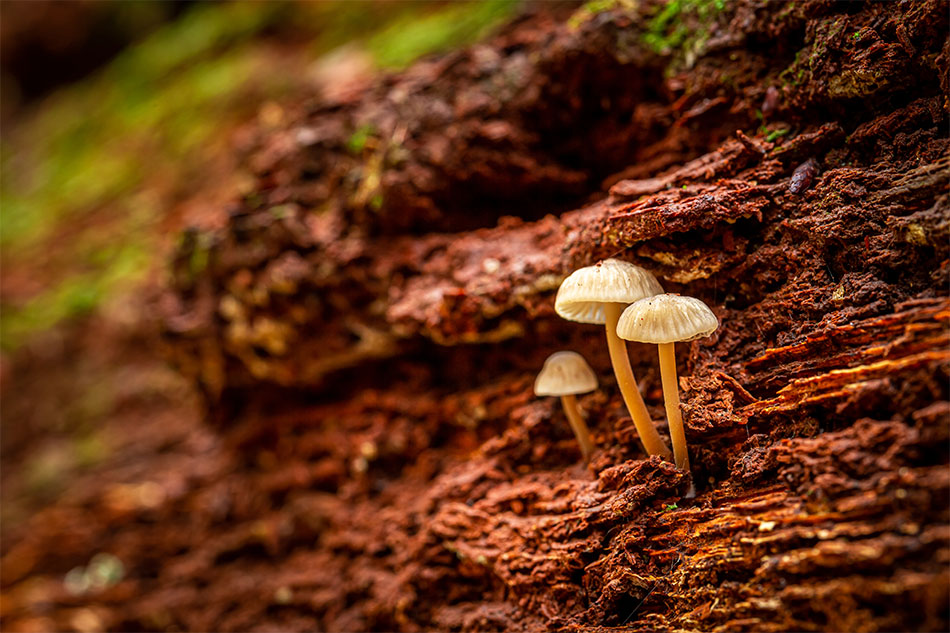
Having explored the intricacies of indoor cultivation and the steps necessary to bring Lion's Mane mushrooms to the fruiting stage, we now transition to the realm of outdoor cultivation.
Growing Lion's Mane mushrooms on logs is a method that closely mirrors their natural growing environment, offering a different set of challenges and rewards. This traditional approach not only connects us to the ancestral roots of mushroom cultivation but also allows us to utilize the natural cycles and resources of the outdoor environment. The process involves several key steps:
Step 1: Selecting and Preparing Your Logs
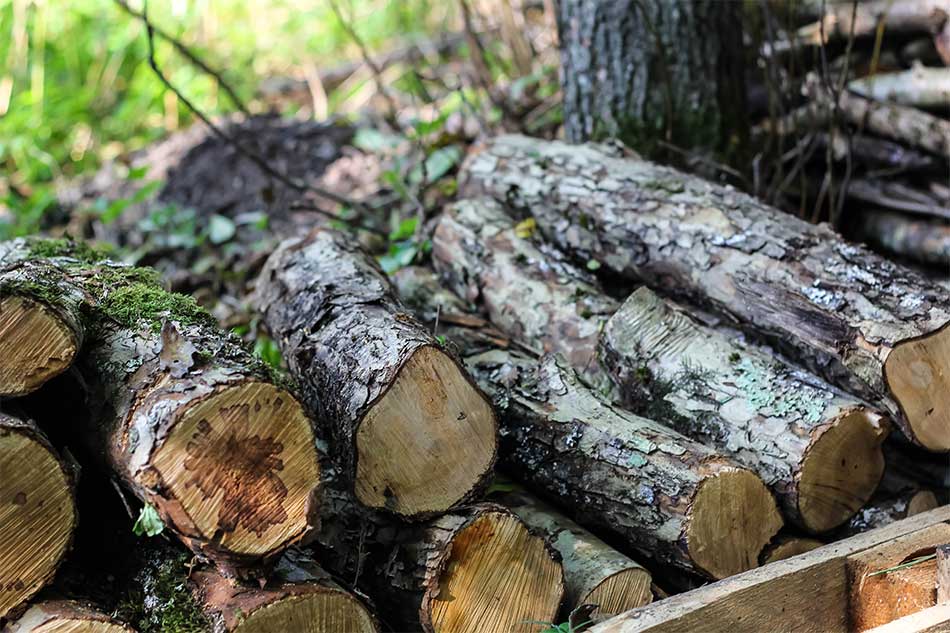
The first step in outdoor cultivation is choosing the right logs. Hardwood logs such as oak, beech, or maple are ideal for Lion's Mane mushrooms. The logs should be fresh, preferably cut within the last few weeks to ensure they still contain enough nutrients and moisture for the mushrooms. They should be free from any signs of decay or other fungal growth.
Step 2: Inoculating Your Logs
Once your logs are selected, the next step is inoculation:
- Drilling Holes: Drill holes evenly spaced around the log. The holes should be deep enough to insert the mushroom spawn plugs.
- Inserting Spawn Plugs: Spawn plugs, which are small wooden dowels covered in mycelium, are inserted into the drilled holes. These plugs are gently tapped into the holes using a hammer.
- Sealing the Holes: To protect the spawn from environmental factors and potential contaminants, the holes are sealed with wax. This wax covering helps maintain the moisture inside the log and prevents other fungi from entering.
Step 3: Incubating Your Lion’s Mane Mushrooms
After inoculation, the logs need to be placed in an environment conducive to mycelial growth:
- Choosing a Location: The logs should be stored in a shaded, moist area, such as under trees or a covered area. This simulates the natural conditions Lion's Mane mushrooms thrive in.
- Monitoring Moisture: While natural rainfall may provide sufficient moisture, during dry periods, it’s important to water the logs to keep them from drying out.
Step 4: Encouraging Fruiting
The fruiting process for Lion's Mane mushrooms on logs is more dependent on natural conditions and can take longer than indoor cultivation:
- Waiting for Natural Fruiting: It may take a year or more for the mushrooms to start fruiting. Patience is key as the mycelium colonizes the log and eventually fruits.
- Maintaining Conditions: Continue to monitor and maintain the logs, ensuring they remain moist and are protected from extreme temperatures.
- Identifying Fruiting: You’ll know that the mushrooms are ready to fruit when you see small formations on the log's surface. These will develop into the characteristic Lion's Mane fruiting bodies.
Outdoor cultivation on logs is a more time-intensive and patience-requiring method compared to indoor cultivation, but it can be incredibly rewarding. This approach allows you to harness the natural cycles and elements, resulting in a truly organic and satisfying mushroom-growing experience.
Harvesting and Storage
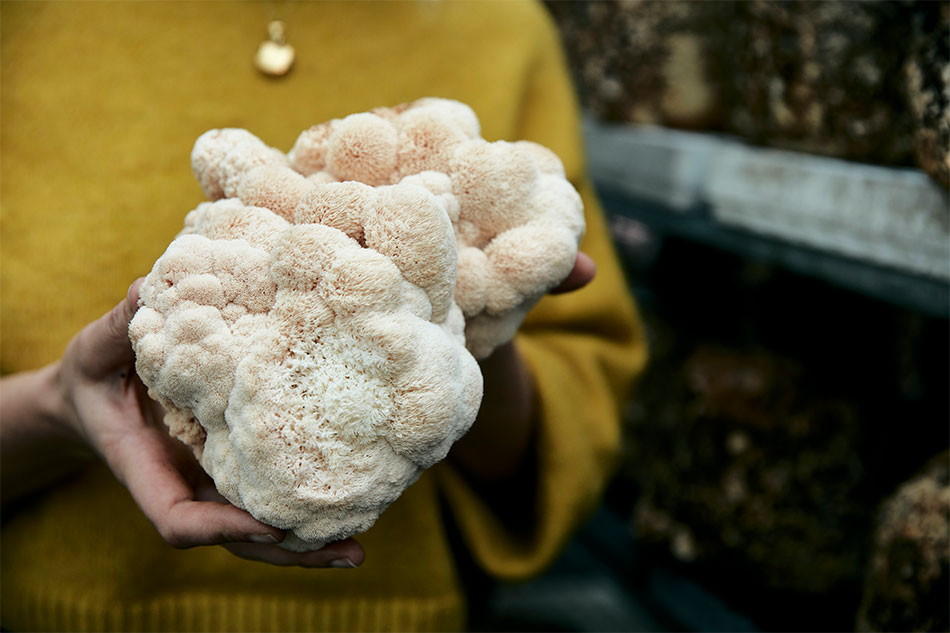
The final and most rewarding stage in cultivating Lion's Mane mushrooms is the harvesting and storage phase. This stage is crucial as it determines not only the quality and flavor of your mushrooms but also their shelf life and nutritional value.
Understanding the optimal time to harvest and the best methods for storing Lion's Mane mushrooms, whether fresh or dried, is essential.
When Should You Harvest Lion’s Mane Mushroom?
-
Observing Growth: Lion's Mane mushrooms are ready to harvest when they are fully formed but before they begin to turn yellow or brown. The ideal time is when the spines or teeth of the mushroom are elongated and still white.
-
Size and Texture: Look for mushrooms that have reached a decent size and have a firm, slightly spongy texture. Harvesting at the right size ensures maximum flavor and nutritional content.
-
Harvest Technique: To harvest, gently twist and pull the mushroom from the substrate or log. Avoid cutting as this can leave behind parts of the mushroom that could rot and affect future growth.
How Should Lion’s Mane Mushroom Be Stored?
Proper storage of Lion's Mane mushrooms is essential to maintain their freshness and medicinal properties.
Fresh
-
Short-Term Storage: Fresh Lion's Mane mushrooms can be stored in the refrigerator for up to a week. Place them in a paper bag or wrap them in paper towels to absorb excess moisture and allow for some air circulation.
-
Handling Moisture: Avoid washing the mushrooms before storing, as added moisture can hasten spoilage. Instead, brush off any dirt gently.
Dried
-
Drying Process: For longer storage, Lion's Mane mushrooms can be dried. Slice the mushrooms thinly and place them in a food dehydrator or an oven set at a low temperature. They can also be air-dried in a well-ventilated area.
-
Storage Conditions: Once fully dried, store them in an airtight container in a cool, dark place. Dried Lion's Mane can last for several months and can be rehydrated for use in cooking or ground into powder for use in teas or supplements.
-
Preserving Nutrients: Drying mushrooms not only extends their shelf life but can also concentrate their flavors and nutrients, making them a versatile addition to various recipes.
In conclusion, timely harvesting and proper storage techniques are key to maximizing the culinary and health benefits of Lion's Mane mushrooms. Whether you choose to consume them fresh or dried, these methods ensure you get the most out of your home-grown mushrooms.
Final Thoughts
The cultivation of Lion's Mane mushrooms presents a unique blend of gardening and personal wellness. This endeavor not only offers the satisfaction of growing your own gourmet mushrooms but also provides an opportunity to enjoy their potential health benefits, known to support cognitive function and immune health.
Whether choosing the controlled environment of indoor cultivation or embracing the natural rhythm of outdoor growth, the journey of nurturing these distinctive fungi is as rewarding as it is therapeutic. The process demands patience and attention to detail, but the result - a bountiful harvest of Lion's Mane mushrooms - is a gratifying and enriching experience.


